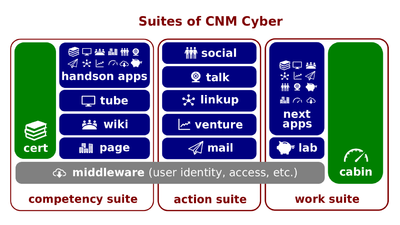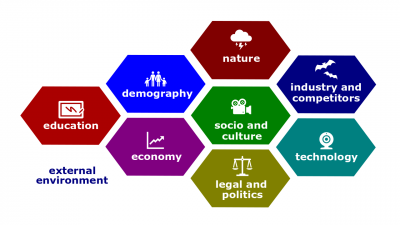Difference between revisions of "Surroundings of Projects"
(→Script) |
(→Script) |
||
| Line 24: | Line 24: | ||
:The project surroundings are too diverse to have a single classification. Here, we will contrast [[internal environment|internal]] vs [[external environment|external]], as well as [[controlled environment|controlled]] vs [[unstructured environment]]s. | :The project surroundings are too diverse to have a single classification. Here, we will contrast [[internal environment|internal]] vs [[external environment|external]], as well as [[controlled environment|controlled]] vs [[unstructured environment]]s. | ||
| − | :[[File:External-environment.png|400px|thumb|right|[[External environment]]]][[External environment]]s are ''environments'' beyond the borders of the [[enterprise]]. | + | :[[File:External-environment.png|400px|thumb|right|[[External environment]]]][[External environment]]s are ''environments'' beyond the borders of the [[enterprise]]. For instance, rapid changes in [[economy]], [[demography]], [[nature]], [[law]]s, [[industry]], and [[technology]] may positively or negatively impact [[project work]]s. |
| − | :[[Internal environment]]s are | + | :[[Internal environment]]s are ''environments'' within the borders of the [[enterprise]]. They include [[project asset]]s and [[enterprise factor]]s. |
| + | :[[Project asset]]s are those organizational resources that a worker or a team can use while working on a [[project]]. The assets are not necessarily monetary. Contents of [[CNM Wiki]] are some of those resources. When you work on your task as a part of the [[CNM Cyber Team]], you can use any of those contents; you may also choose not to use any. | ||
| + | :[[Enterprise factor]]s are those conditions that direct and constrain [[project work]]; these conditions are imposed by either the [[organizational culture]]s or organizational [[workforce]]. When you work on a ''project'', these conditions are not under your immediate control. | ||
| + | :For example, the [[CNM Cyber Team]] uses [[CNM Wiki]] for its work on requirements. You may like it or not, but, if you work on requirements as a part of the ''Team'', you have to use the ''Wiki''. | ||
| − | [[ | + | :Similarly, you cannot change [[Personality|personalities]] of your teammates, their approaches to work, or even availability. People are people. They get sick, face family situations, and/or change their employment. |
| − | + | :[[controlled environment|controlled]] and [[unstructured environment|unstructured]] | |
| − | |||
| − | |||
| − | |||
| − | |||
| − | |||
| − | |||
| − | |||
| − | :[[controlled environment|controlled]] and [[ | ||
===Key terms=== | ===Key terms=== | ||
Revision as of 14:32, 26 November 2020
Surroundings of Projects (hereinafter, the Lectio) is the lesson part of Project Work Essentials lesson that introduces its participants to project management concepts. This lesson belongs to the CNMCT Entrance section of the CNM Cyber Placement.
Content
The predecessor lectio is Developments at the Wiki.
Script
- Project environments are those natural and human-made surroundings in which those who work on a project perform. The most important ones are those surroundings that impact or may impact the project cost, project timeline, and/or work product.
- Project costs are money that are spent to complete the project. Project budgets are those financial plans that estimate project costs. Unexpected expenses, increased costs, or inability to pay on time may negatively impact the performance on a project.
- Project timelines are linear representations or displays of chronological order of project milestones. Project schedules are those temporal plans that estimate when the needed resources be received, work products be completed, and deliverables be shipped.
- A work product is a solution, component of a solution, or any other output from any endeavor. Usually, a work product is a deliverable, but not every work product becomes a deliverable. A deliverable is any work product that one party has agreed to deliver to another.
- When it comes to development of work products, the main question is whether this development is controllable. For instance, whether the raw materials or parts can be available on time. Or whether development requires special conditions such as security clearances of the developers. Finally, whether developers generally know how to develop the work product.
- Scripted-work products are those work products that development process is structured and known in details. They would include constructions, non-designer clothing, and foods prepared according to recipes.
- Unscripted-work products are those work products that development process is unstructured or unknown. They would include first ever radio, first ever airplane, and first ever computer. If developers have no instructions for developing something, development of this something is unscripted.
- Creative works such as content development and design always include both scripted and unscripted aspects. Extremely-exclusive web-design can take a few years and more than a million dollars to develop. It can also take few hours and peanuts to clone or modify some existing design. Since schedules for creative works cannot be really calculated, the customer usually simply sets up their project budgets and/or schedules, so developers would manage their effort.
- The project surroundings are too diverse to have a single classification. Here, we will contrast internal vs external, as well as controlled vs unstructured environments.
- External environments are environments beyond the borders of the enterprise. For instance, rapid changes in economy, demography, nature, laws, industry, and technology may positively or negatively impact project works.
- Internal environments are environments within the borders of the enterprise. They include project assets and enterprise factors.
- Project assets are those organizational resources that a worker or a team can use while working on a project. The assets are not necessarily monetary. Contents of CNM Wiki are some of those resources. When you work on your task as a part of the CNM Cyber Team, you can use any of those contents; you may also choose not to use any.
- Enterprise factors are those conditions that direct and constrain project work; these conditions are imposed by either the organizational cultures or organizational workforce. When you work on a project, these conditions are not under your immediate control.
- For example, the CNM Cyber Team uses CNM Wiki for its work on requirements. You may like it or not, but, if you work on requirements as a part of the Team, you have to use the Wiki.
- Similarly, you cannot change personalities of your teammates, their approaches to work, or even availability. People are people. They get sick, face family situations, and/or change their employment.
Key terms
Closing
The successor lectio is What Project Work Is.

